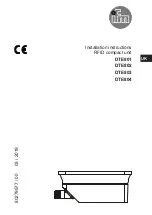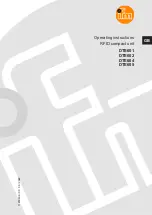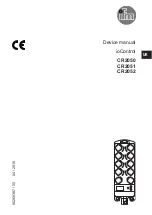
EN
6
R
EXTREMELY IMPORTANT
Read these safety instructions carefully in addition to the instructions for use, operation and maintenance and keep them in a safe
place for future consultation.
This table has been designed to lift, lower and possibly move elements. Any other application, beyond the conditions established
for use of this table will be considered inappropriate. The elevation and movement of heavy loads may be dangerous if it is not
performed correctly.
Handle the table correctly and prior to its use, ensure that all parts and components are in good condition and that no parts are
missing.
Only authorised persons should operate the table having read carefully and understood the contents of this manual.
Do not modify the table in any way.
Non-compliance with these rules may result in injury or damage to the user, the table or the piece to be lifted.
The manufacturer accepts no responsibility for the improper use of the table.
1. SAFETY INSTRUCTIONS
1.1 The load to be lifted should never exceed the rated capacity of the table.
1.2 The maximum stroke of the table indicated on the label should never be exceeded.
1.3 The load should always be centred over the table (A). Prevent any type of slipping by using slings or other types of securing
elements.
1.4 The table should be supported on a solid, level and horizontal surface. Never use it in a slanted position.
1.5 The table should be used in such a way that it can be operated without the need for the user to introduce any part of his/her
body underneath the load to be lifted or inside the chassis of the table (E). Never work under an elevated load without previously
supporting it with mechanical stands.Our tables are equipped with safety bolts to lock the table at different heights.
1.6 Use of this device for the elevation or transportation of individuals is forbidden (D).
1.7 The operator should be able to observe the lifting device and the load during all movements. Immobilize the table during lifting
or lowering operations. If the load tilts or sways during operation, maintain a safety distance and do not attempt to hold it steady.
1.8 Keep the work area well illuminated and free of unnecessary elements.
1.9 The table is a lifting and lowering device and therefore it should not be used as a permanent means of transportation. To move
the load a short distance, keep the table in its lowest position, check that the floor is clean and non-slippery, there is full frontal
vision and the table does not bump into obstacles in its path.
1.10 Non-compliance with these essential safety instructions may result in injury or damage to the user, the table or the element
to be lifted.
1.11 As an additional safety measure against overload, the table is fitted with an overload valve which has been set at its maximum
work pressure at the factory. This valve should not be adjusted under any circumstances.
2. USE AND OPERATION
2.1 Prior to operating the table, remove any accumulated air from the system as follows:
- Insert the handle into the socket and fix it with the screw provided.
- Pull the handle and turn it clockwise and, whilst held in this position, pump the table several times to ensure internal
lubrication and bleed the accumulated air from the system.
2.2 Release the handle and it will automatically return back to the initial position (“Dead man principle”). The table is now ready
to be used.
Important: Prior to lifting the load, ensure that all of the aforementioned safety instructions are followed.
2.3 The load is lifted by pumping the handle in a downwards movement (B). Check that there are no obstacles above the table. To
facilitate a quick approach to the load, our tables are fitted with a pumping pedal.
2.4 Prior to lowering the load, check that there are no obstacles or persons under the platform. The load is lowered by gradually
turning the handle in an anti-clockwise direction (C). Our tables are fitted with an automatic adjustment and control system (L.C.S)
to avoid brusque lowering.
3. MAINTENANCE
3.1 Both the maintenance and repair of this table may only be carried out by qualified and authorized personnel, who as a result of
their training and experience are familiar with the hydraulic systems used in these devices.
3.2 Regularly clean and lubricate the axes of the moving parts of the table (F), which should be kept clean and protected from
aggressive conditions at all times.
3.3 Only original spare parts should be used.
3.4 Prior to each use, check for bent, broken, cracked or loose parts and solve the problem, if appropriate. If it is suspected that
the table has been subjected to abnormal loads or has suffered any knocks, withdraw it from service until the problem has been
rectified.
3.5 If the oil needs to be refilled, dismantle the hydraulic unit and with the piston fully retracted, remove the filler plug and drain its
contents into a container. With the hydraulic in a horizontal position, proceed to introduce the necessary volume for each model
as indicated in these instructions. Avoid the entrance of any dirt with the new oil.
3.6 Following a period of prolonged intensive use, it is recommendable to change the oil in order to extend the useful life of the
table. Important: An excess of oil to the volume required may render the table inoperative.
3.7 Only use hydraulic oil, type HL or HM, with a maximum ISO grade of cinematic viscosity of 30 cSt at 40º, or an Engler viscosity of 3 at
50ºC.Extremely important: Never use brake fluid.
3.8 When the table is not in use, it should be fully retracted in its lowest position so as to minimize piston corrosion. We recommend
applying an anti-corrosion product to the main piston and to that of the pump.
3.9 Store the table in a dry, clean place, out of the reach of children. Remove the handle from its operating position.
3.10 At the end of the useful life of the table, drain off the oil and hand it over to an authorised agent and dispose of the remaining
OK
10130001001.05.
Abr
.20






























